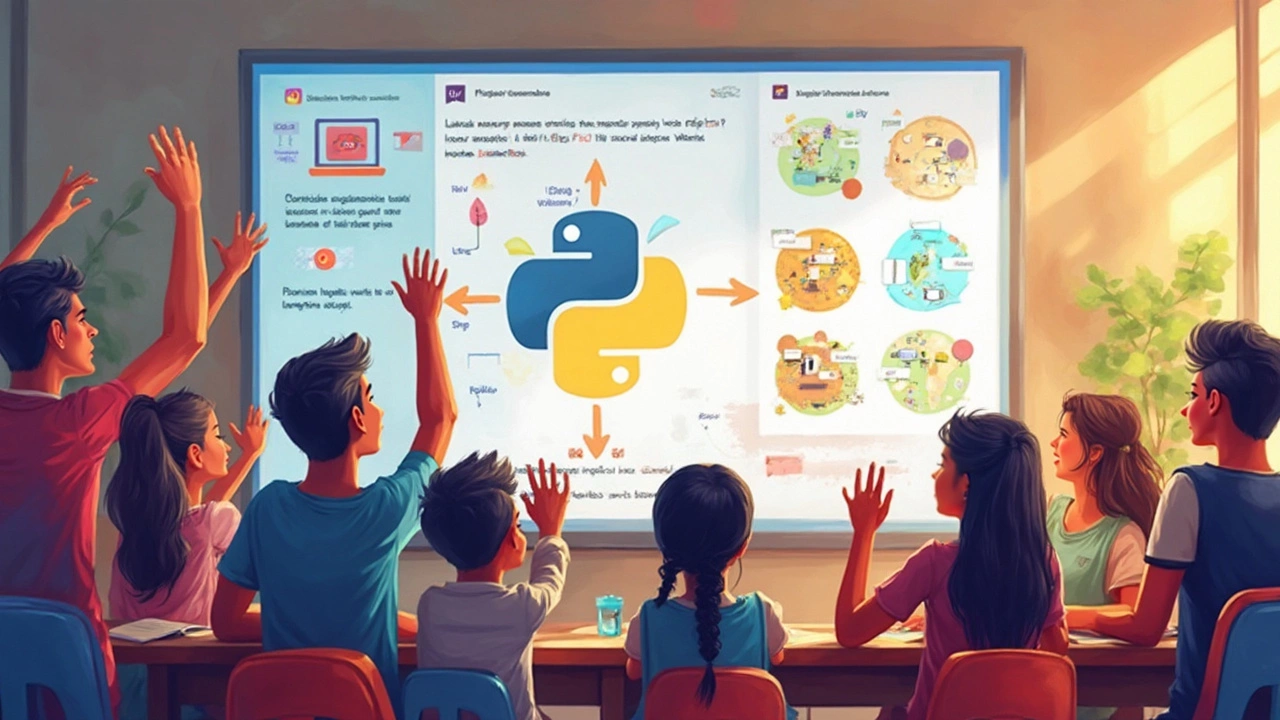
So, you're thinking about learning Python and you’re wondering if it's a tough nut to crack. Spoiler alert: Python is actually one of the most beginner-friendly programming languages out there. Thanks to its clean and simple syntax, it’s as close to English as a programming language can get. Imagine writing a to-do list instead of deciphering wall inscriptions—I’m not kidding, it’s almost that straightforward.
Now, don’t get me wrong, this doesn’t mean you won’t scratch your head a few times. But the learning curve is surprisingly gentle compared to other programming languages like C++ or Java. It's great for newbies to coding but also powerful enough for pros building complex projects.
Why Python is Popular
If you're wondering why everyone's talking about Python, you’re not alone. From budding coders to industry giants, it seems like everyone is leaning on Python these days. But what makes it so special?
First off, Python's got a reputation for being super user-friendly. Its syntax is designed to be readable and straightforward, making it less intimidating for beginners. Imagine writing instructions in plain English and that's pretty much what coding with Python feels like.
Another big deal is Python's versatility. Need to build a web app? Python's got you. Diving into data science? Python can crunch those numbers. This language isn’t just restricted to one field; it spans across various domains like artificial intelligence, game development, and even automation.
Plus, there's an enormous supportive community. You know what that means? Tons of libraries and frameworks ready to make your life easier. Whether you’re tapping into Django for web development or using NumPy for scientific calculations, the Python community is there to back you up with solutions and support.
Check this out: Python consistently ranks as one of the top programming languages in several surveys. According to a survey by Stack Overflow in recent years, Python was the third most-loved language, and it keeps climbing the ranks. Its popularity has skyrocketed especially in fields like data science and machine learning.
If you're worried about job prospects, Python's got you covered there too. Companies across the globe are on the lookout for Python developers. Its simplicity yet efficiency is exactly what businesses crave in a fast-paced technological world.
In short, Python wins hearts because it’s like the Swiss Army knife of programming: multi-talented and easy to use. It welcomes beginners with open arms and evolves seamlessly for advanced coders tackling more complex projects.
Understanding Python Basics
Alright, so you're diving into Python, and the first step is to get comfy with its basics. Don't worry, it's not rocket science. In fact, Python's design makes learning coding feel less like wrangling with math problems and more like telling the computer what to do with a friendly nudge.
Let's start with the syntax. It's all about readability here. Python uses indentation (spaces or tabs) to define the block of code. While this might sound trivial, it's what makes Python code neat and pleasing to the eye. No curly braces here!
- Variables: Think of them as labeled boxes where you store data. You assign a value with an equal sign, like
age = 25. - Data Types: Python comes with several built-in types like integers, floats (for decimals), strings (text), and booleans (True/False). Understanding these helps in performing operations on your data.
- Control Structures: These are the ifs, elses, and loops of your code. They help you decide which path to take. For instance, you might use an
ifstatement to check if a condition is True before executing a piece of code. - Functions: Think of a function like a meal recipe. You define it once and can use it anytime by ‘calling’ it. Python’s built-in functions, like
print()orlen(), save you time, but making your own can supercharge your workflow.
To give a peek into Python's world, here's a little code snippet that sums up how these basics tie together:
def greet(name):
if name:
return "Hello, " + name + "!"
return "Hello, world!"
print(greet("Bob"))This simple function checks if you provided a name and returns a greeting. If there's no name, it defaults to a generic hello world. See? Not too hard!
Getting a grasp on these basics will give you a good foundation to tackle more advanced concepts. Once you're comfortable, the sky's the limit on what you can do with Python, from developing web applications to crunching data like a pro!

Finding the Right Resources
Alright, you’ve decided to dive into Python, but where do you start? There are loads of resources out there, but picking the right ones can make a huge difference in your learning journey. The key is to find those that fit your style and level.
For absolute beginners, online platforms like Codecademy and Coursera offer structured courses that guide you through Python fundamentals. They provide interactive lessons that keep you engaged and help you practice as you learn. Watching YouTube channels like Programming with Mosh or Corey Schafer is like having a personal tutor, minus the cost.
If you like reading, “Automate the Boring Stuff with Python” by Al Sweigart is a winner. This book makes programming fun and applicable to everyday tasks. It’s packed with practical examples that show you how Python can simplify your life.
Sometimes, local coding clubs or meetups, often listed on platforms like Meetup.com, can be golden. These events provide a community vibe and real-time help from folks who’ve been there, done that. It’s like being a part of a team rather than going solo.
And don't underestimate the power of forums like Stack Overflow. When you get stuck—because let’s face it, everyone does—the community here can be a lifesaver. Just don’t forget to do a quick search before posting your question, because chances are, someone else has been in your shoes.
If you prefer a more organized learning path, some online bootcamps, like Udacity or edX, offer intensive Python courses. They often feature projects that you can include in your portfolio, which is great if you're looking to use Python professionally.
Python in Action
Alright, let's talk about where Python really shines. You've probably heard it's all about versatility. And it's true! From web development to data science, there’s a lot you can do. Have you ever used Instagram or Spotify? Yep, both are powered by Python. It's not just for the big players though; even small businesses love it for creating apps and automating repetitive tasks.
If you're venturing into data science, Python is a game-changer. It has libraries like Pandas and NumPy for crunching data and Matplotlib and Seaborn for whipping up cool charts. For those diving into artificial intelligence, TensorFlow and Keras are right up your alley. They make building and training machine learning models a whole lot easier.
Let's not forget about web development. Here, frameworks like Django and Flask make creating websites feel like a breeze. Want to build an online store or a personal blog? Python’s got your back with these tools. The best part? They're free and have huge communities that are always ready to help.
Got a knack for automating boring tasks? Python's good at that too. Ever wanted to scrape some web data? You can use libraries like BeautifulSoup to automatically collect data without all the manual clicking.
Check this out:
| Field | Popular Libraries |
|---|---|
| Data Science | Pandas, NumPy |
| Machine Learning | TensorFlow, Keras |
| Web Development | Django, Flask |
| Web Scraping | BeautifulSoup |
The beauty of learning Python is that once you start, you can pivot into so many different areas. Whether you're a college student, a working professional, or just someone curious about the tech world, Python opens up a raft of opportunities. It’s why folks from varied backgrounds choose Python as their first programming language. So, why not give it a go and see how handy it can be?
